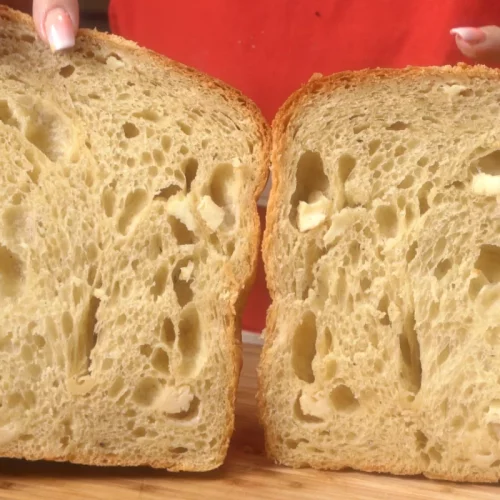If you’ve ever visited central Italy around Easter, you may have seen a golden, towering loaf on the breakfast table—rich with cheese, pepper, and tradition. Known locally as Pizza al Formaggio, Torta di Pasqua, or Pizza di Pasqua, this is not a pizza in the modern sense, but rather a savory Easter bread that’s deeply rooted in the food traditions of Umbria, Marche, and parts of Tuscany.
🎥 Watch the full step-by-step in our video below to see the shaping, mixing, and baking in action.
🎥 How to Make Italian Easter Cheese Bread (Watch the Video Recipe!)
Subscribe to our YouTube Channel
More video recipes? Subscribe to our YouTube Channel (it’s FREE) and click the bell to get notifications when we release a new video recipe!
📜 A Bread with Ancient Roots
The word pizza originally meant “pie” or “round baked good” long before it came to mean tomato-topped flatbread. In this case, Pizza di Pasqua is a rich, eggy, cheesy bread that goes back to at least the Middle Ages, when monks and villagers would celebrate Easter with special, symbolic foods after Lent.
Eggs and cheese—foods traditionally avoided during Lent—return to the table in full force. This bread became a symbol of resurrection and abundance, baked in large quantities and gifted to neighbors, priests, and even farm workers as a gesture of goodwill.
🌿 Regional Variations: Umbria vs Marche vs Tuscany
While the name and ingredients are similar, each region has its own twist on Pizza al Formaggio:
Umbria
- Uses a combination of grated and cubed pecorino
- Often includes lard (strutto) for richness
- Typically shaped in a tall cylindrical mold (like panettone)
- Seasoned with plenty of black pepper
- Baked the day before Easter and eaten with eggs, salami, and wine for breakfast
Marche
- Often adds Parmigiano or Emmental
- May include small amounts of baking powder for a fluffier texture
- Slightly milder in cheese intensity
- Some families add milk or butter in place of strutto
Tuscany
- Known as schiacciata di Pasqua in some towns
- Sometimes flavored with anise seeds or citrus zest (sweet versions exist too!)
- Shorter and more cake-like in texture
No matter the version, the common thread is cheese, eggs, and celebration.
🧀 Why This Recipe Works (Umbrian-Style)
This recipe, shared by Flavia Diamante of PIATTO™, follows the Umbrian tradition closely. It uses:
- A slow-rise biga starter (Primo Impasto) for flavor and structure
- Two types of pecorino cheese: grated (for aroma) and cubed (for melty bites)
- A mix of olive oil and lard for a tender crumb
- Freshly ground black pepper for balance
The result is a fragrant, springy bread with a golden crust and savory interior—perfect sliced warm or toasted.
🍽️ How to Serve Pizza al Formaggio
Traditionally, this bread is served on Easter morning, accompanied by:
- Hard-boiled eggs or a frittata
- Capocollo, salame, prosciutto
- A glass of red wine (Sagrantino, if you’re truly Umbrian)
But it’s just as wonderful:
- Toasted and spread with butter
- Served with soup or salad
- Packed in a spring picnic basket
🧠 Tips for Success
- Use a panettone mold or tall springform pan for the traditional height
- If you can’t find lard, use butter or add more olive oil
- Pecorino can be intense—adjust the amount if you’re using a very sharp variety
- Don’t skip the long rise—this bread gets better the longer it rests
- Let it cool completely before slicing to avoid gummy texture
❄️ Storage & Reheating
- Wrap tightly in foil and keep at room temp for 2–3 days
- Freeze in slices for up to 2 months
- Reheat in a low oven or toaster for best flavor
🛠️ Recommended Equipment
- Stand mixer with dough hook: https://amzn.to/3YtLxQW
- Kitchen scale: https://amzn.to/42ojxk1
- Tall, round bread mold:
- Proofing container or large bowl
- Pastry spatula and dough scraper
- Oven thermometer
As an Amazon Associate, we earn from qualifying purchases. This means at no extra cost to you, PIATTO may earn a small commission if you click the links and make a qualifying purchase.
🧀 Italian Easter Cheese Bread: Pizza al Formaggio di Pasqua
Equipment
- 1 tall round bread mold Dimensions: 21 cm (8.3 inches) diameter × 13 cm (5.1 inches) height
- 1 stand mixer with dough hook
- 2 mixing bowls for preparing the biga (starter) and mixing other ingredients.
- 1 digital kitchen scale Purpose: Accurate measurement of ingredients, crucial for baking precision.
- 1 thermometer optional; Instant-read or probe Purpose: Ensures the bread reaches the desired internal temperature of 95°C (203°F) for proper doneness.
- 1 proofing container or large bowl with cover
Ingredients
First Dough (Biga)
- 200 g flour
- 90 g water
- 1 g dry yeast
Second Dough
- all first dough (biga) after 12h proof
- 150 g strong flour strong bread flour
- 150 g medium flour
- 10 g malt 10 g = ½ tablespoon
- 60 g creamy mother dough (sourdough yeast) 60 g creamy sourdough yeast = 3 g dry yeast
- 90 g milk
- 8 g salt
- 6 g freshly ground black pepper
- 180 g whole eggs 180 g = about 3–4 large eggs
- 50 g extra virgin olive oil
- 40 g lard strutto
- 200 g grated Pecorino Romano
- 250 g cubed Pecorino Romano
- 40 g water to help incorporate the pecorino
Instructions
Prepare the Primo Impasto (Biga):
- Mix the flour, water, and yeast until just combined.
First Dough Proof
- Cover and let proof at 20–22°C (68–72°F) for 12 hours or overnight.
Start the Secondo Impasto:
- In the bowl of a stand mixer, add the milk, malt, ⅓ of the eggs, and the biga/starter. Mix until foamy.
- Add the flours and mix until the dough begins to come together and form a gluten mesh.
- Gradually add the melted lard and olive oil in 2 batches (reserve a small amount for later when adding cheese). Mix well after each addition and check the gluten structure.
- Add the second third of the eggs and mix. Check gluten again.
- Add the remaining fat and eggs, followed by the cheeses, salt, and pepper. Mix thoroughly and verify gluten development once more.
- Transfer the dough to a clean surface. Fold every 20 minutes, 3 times total.
Second Dough Proof
- Let the dough proof at 28–29°C (82–84°F) for about 2 hours or until nearly doubled in size.
- Shape the dough into a tight snail shape and place into a greased and floured tall baking mold.
- Proof again at 28–29°C until it reaches the top of the mold (for mushroom shape after baking) or 1 inch below the top (for domed shape).
Bake
- Place in a static oven (bottom heat only if possible) at 170°C (340°F) for the first 30 minutes, then reduce to 150°C (300°F) for a total bake time of 50 minutes. Internal temperature should reach 95°C (203°F).
Video
Notes
- Traditional Umbrian Easter bread—rich, savory, and packed with Pecorino cheese.
- Best enjoyed with eggs, salumi, or a glass of red wine.
- Let cool completely before slicing. Can be frozen in slices for up to 2 months.



Amazing and definitely worth the time and effort!! Thanks Flavia!
Original comment: View on YouTube